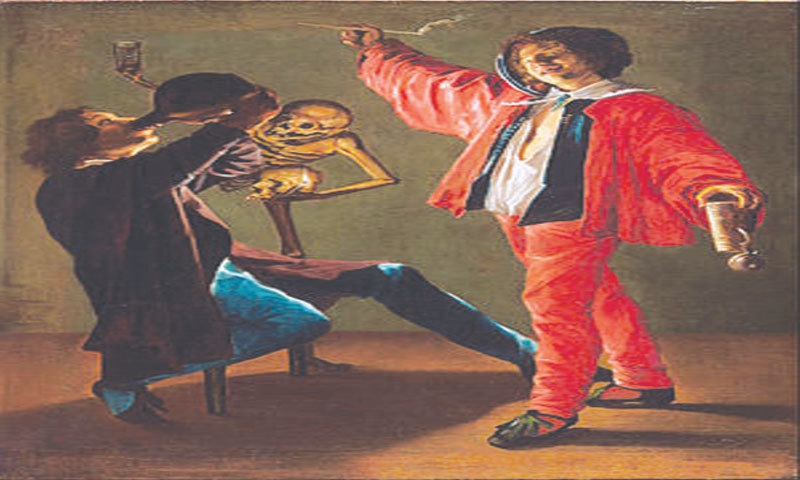In 1909, a group of Italian painters shocked the art world with a manifesto that denounced classical art and art museums. These ‘futurists’ spoke of exalting the war and the ‘reckless artist’ who celebrated modern-day objects that demonstrated aggression, mechanical velocity and technology. “A race car, its hood adorned with big pipes, like snakes with explosive breath, a roaring automobile, which seems to race along machine gun fire, is more beautiful than the ‘Winged Victory of Smothrace’,” wrote founder of Futurism and art theorist F.T. Marinetti in his Manifesto of Futurism (1909). Futurism is a modern art movement where the painted or sculpted object often represents “dynamism in art” — a phenomenon that involves changing states of matter and motion. These characteristics of futurist art, among many other modern art styles and movements, are thus dependent on the observance of time.
Italian painter Umberto Boccioni represented time and movement through many works, his most famous being the ‘Unique Forms Of Continuity In Space’ (1913). As the bronze sculpture is based on a human figure whose armless upper torso and legs organically mould into each other, the reality of transcending time channels through this sculpted representation of motion and fluidity of matter.
Similarly, ‘The Cyclist’ (1913) by Russian painter Natalia Goncharova shows a man on a bicycle as Russian words for ‘hat’, ‘silk’ and ‘thread’ are seen on the billboards behind him. The painting breaks down the speed of the vehicle via its two-dimensional format, as the side-view of the bicycle and the man is visually multiplied to portray the relationship between movement and time, second by second, within the painting’s composition.

The fascination with time may have been expressed by modern artists but the concept is certainly not new in Western history of art. Symbolically, time is often represented through the concept of vanitas and memento mori in Dutch genre painting of the 16th and 17th centuries. Philosophically, vanitas represented the passing of time and the worthlessness of mundane pleasure, while memento mori brings our attention to the certainty of death. In ‘The Last Drop’ (1639) by Dutch painter Judith Leyster, two inebriated men are shown: the seated young man on the left of the painting drinks from a round flask while his companion stands beside him on the right. A skeleton behind the two men tries to grasp their attention with a skull in its hand. Leyster overlaps vanitas (the cheerful and drunk youth) with memento mori (the skeleton and the skull) to ultimately hint at the unstoppable passage of time that will eventually lead the two men to their deaths.
Gradually, the concept of time expanded beyond skulls and hourglasses in painting, as the art movement of ‘Impressionism’ (late 1800s) focused on how time visually affected the outdoors. ‘Haystacks’ (1890-91), a series of paintings by French painter Claude Monet illustrates a harvested stack of wheat in the open, where the changing light from different times of the day illuminates the landscape with varying colours and aerial atmospheres. Monet also painted landscapes during sunrise and sunsets, as they appeared to his eyes, to illustrate the scenic outdoors as naturally as possible with observable differences during the varying hours of the day.
Time as a concept and reality has captivated many artists throughout the history of art
While eras, concepts, and media differ in the execution of art, one unifying and observable element is an attempt by artists to comprehend how time ages human beings and limits ambition due to the indestructible quality of death. Artists have reflected by merging this reality with the human psyche and functions such as sleep and memory. Surrealism underpinned the field of psychology in the 20th century to understand time through paintings of everyday articles, as experienced by a human being’s ‘unconscious mind.’

Works by Spanish painter Salvador Dali often exemplify the relationship of the mind with the passage of time. In his painting ‘The Persistence Of Memory’ (1931), Dali revises the imagery of ticking clocks into ‘melting’ watches, placed in an eerily deserted landscape that also contains a wooden top, a tree branch and mountains in the background. Through this work, Dali symbolically uses the imagery of the watches to refer to the slippage of memory, sleeping and unconscious states of the human mind, and the connection between space and time.
The Russian-French artist Marc Chagall once said, “Time is a river without banks”. In a similar way, the reality of time has been captivated in multifaceted and unlimited ways in art. Spectators will perhaps continue to see further engagement with time as a symbol, a theme, a scientific and/or philosophical concept in art, in time to come.
Published in Dawn, EOS, July 31st, 2020














































Dear visitor, the comments section is undergoing an overhaul and will return soon.